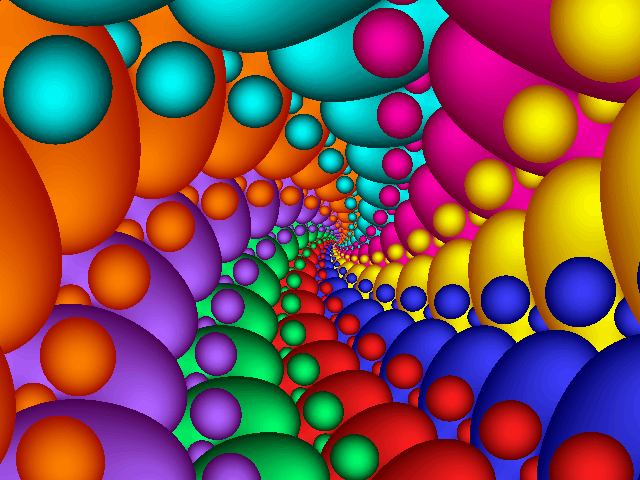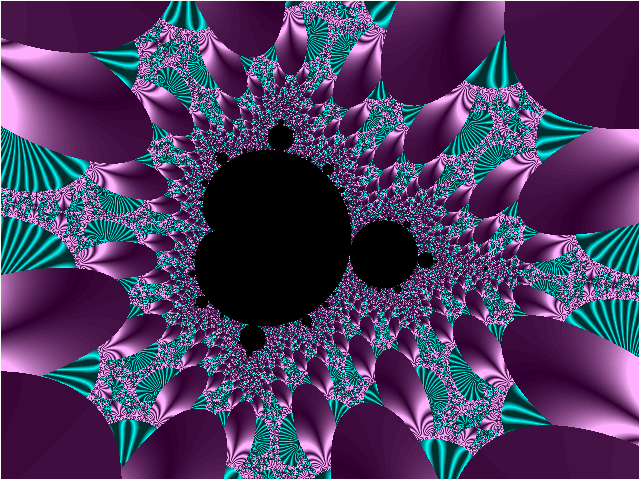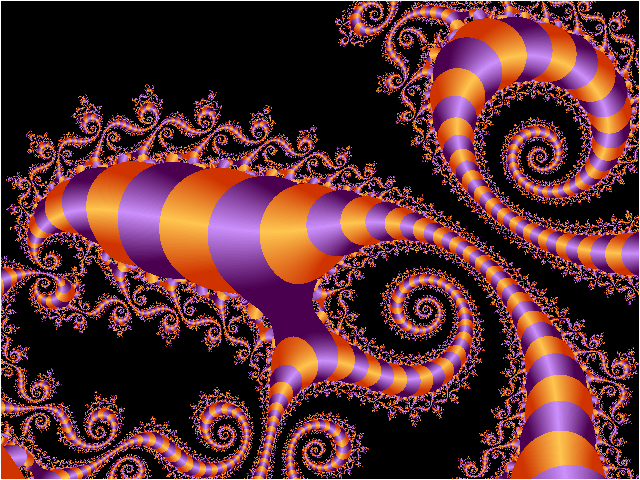![]()
Comments on Suggested References for Fractal Images
Created Using Julia Sets and the Mandelbrot Set
![]()
Book:
H.-O. Peitgen and P. H. Richter, "The Beauty of Fractals",
Springer-Verlag, 1986 ( About $ 55 )
This book contains a beautiful set of fractal images. They were exhibited at several art museums in Europe and the United States during the 1980s. There is an excellent general introduction to fractals, and a discussion of the relation between points near the boundary of the Mandelbrot set and the types of images produced.
An appendix gives the values of the image parameters so that readers can reproduce these pictures on their home computers if they have a suitable fractal generation program.
It also contains 10 more rigorous sections on the mathematical
basis for these fractal images, which are very well done, but require a
considerable background to appreciate. Finally, there are four invited
sections, three by mathematicians and one by an artist who works with technically
assisted art images.
![]()
VHS Video Tape:
"Fractals: The Color of Infinity", Narated by Arthur
C. Clarke,
Films for the Humanities and Sciences, 1997 ( 52 minutes
)
This film was produced in 1994. It contains some excellent film clips showing continuous zooms into areas near the boundaries of the Mandelbrot set. It also shows the effects of varying the color gradients on the images obtained. These are very well done.
However, while Clarke is an impressive narrator, his rhetoric considerably exaggerates the importance of fractal geometry to our understanding of the real world. There is a major logical flaw in his reasoning, which seems to be as follows: The world contains complex geometrical objects; fractals are complex geometrical objects; therefore there must be a fundamental relationship between the mathematics of fractals and the physical world. The fact that the cross-section of a cancerous tumor has a complex boundary ( with a fractional dimension ) does not mean that a knowledge of fractals will be of any help in understanding cancer. His predictions of future developments in this field are also very dubious.
Fractal geometry was an important development in some areas of pure mathematics, and the use of computers in the study of these areas has proven to be very useful.
Fractal programs have also found a considerable niche market in the area of computer assisted art, and they can produce beautiful pictures. This, by itself, is a significant achievement.
One very promising application of fractal geometry
was thought to be for the efficient compression of still and video images.
This does have great commercial value. However, the development of other
techniques for doing this has been so rapid and so successful that the
use of fractals for this purpose is no longer of great interest.
![]()
Links to Some Fractal Web Sites:
NASA
Fractal Gallery
Fractal
Explorer
Fractint
Home Page
Yahoo
Fractal Directory
The Infinite
Fractal Loop
NASA Fractal Gallery
The NASA Fractal Gallery displays a wide range of various
types of fractal images. This is part of a K-12 program to stimulate
the use of computers in the senior year of high school by providing examples
of a computer graphics application. It contains a good selection of high
resolution images. The thumbnail versions are quite small, however, and
don't do justice to many of the images.
Fractal Explorer
Many people have probably been fascinated by the infinite
complexity and beauty of fractals. I wrote this brief tutorial to explain,
in simple terms, how the Mandelbrot
set and Julia
sets are generated. This document provides an informal introduction
to these subjects, and is only intended to be a starting point to learn
more about fractals and fractal geometry. The Fractal Explorer web site
contains a good introductory discussion of the mathematical basis for the
Julia Sets and their relationship to the Mandelbrot Set. It is a very well
organized individual site, created by Fabio Cesari, and contains an excellent
selection of images.
Fractint Home Page
The Fractint Home Page web site is the primary reference
source for the freeware program "Fractint". This is one of the most widely
used fractal programs for PCs. It was originally written for DOS. It is
very flexible, and allows users to add their own programs for various functions
which can be used as a basis for the generation of novel types of fractal
images.
Fractint is a freeware fractal generator created for
IBMPC's and compatible computers. It is the most versatile and extensive
fractal program available for any price. The authors work very hard to
keep it that way. It has many great features and it is constantly being
upgraded and improved by the Stone Soup team. Keep this link as a reference
to stay up-to-date with the latest developments.
Yahoo Fractal Directory
The Yahoo search engine provides an extensive listing of web sites with galleries of fractal images. The quality of the images in these galleries varies widely. Other search engines will provide similar information after a search for "fractal".
There are also a number of "Web Rings" which link groups of web sites sharing a common interest. "The Infinite Fractal Loop" is one of the largest of those devoted to fractals, with about 140 sites. Its theme is "Fractal Art".
Anyone with a web site can start a web ring on a particular
topic if he or she is willing to allocate about 300 KB of disk space and
the time required to manage it. A small amount of space is also required
from each member, in order to provide links to other members. A number
of ISPs, including AT&T and GeoCities, will provide the information
required to set up such a ring.
![]()
A Fractal Computer Program for Windows 95/98
Corel Photo-Paint 8 with the KPT "Julia Set Explorer
2.0" Plugin Filter
This is the program used to generate many of the fractal
images. The KPT plugin is one of a set of three that were available in
"Kai's Power Tools Version 2": the "Julia Set Explorer", the "Mandelbrot
Set Explorer", and the color "Gradient Designer". Only the Julia Set plugin
is supplied with Corel Photo-Paint.
The two Kai fractal plugins were also included with
the KPT 3 version as "classics". The recent KPT 5 (which supplements KPT
3 ) contains a new fractal plugin, "FraxPlorer". It's an improvement in
many ways, but it has a serious defect for PC users. It does not allow
the constant term, "C", to be set or read out numerically. These filters
require a graphics program which supports Adobe compliant plugins. They
should work with Corel Photo-Paint 8 and MetaCreations Painter as well
as with Adobe PhotoShop ( but caveat emptor ).
The Julia Set Explorer 2, supplied with with Photo-Paint 8, is a very good program which generates 24-bit color images. The user interface makes it very easy to vary the Julia Set constant over the complex plane. An outline of the Mandelbrot Set is displayed in the window which is used for this purpose. All of the program parameters can be set and read-out numerically. The result can be viewed, almost in real time, on a preview window, and the application of the color gradient can be controlled easily and quickly over a wide range of parameters. Its response time is much faster than that of the new FraxPlorer plugin when used with Corel Photo-Paint 8.
There are also numerous freeware and shareware stand-alone programs for generating fractal images. They are discussed at many of the fractal web sites. The DOS "Fractint" program seems to be one of the most popular of these programs, but there are many others.
Writing the code for a program to generate fractal
image patterns is fairly easy. Making the code efficient and creating a
convenient graphics user interface, however, is considerably harder.

![]()
Some Fractal Pictures



Fast access to the
following different links
A Note on the History of Fractals